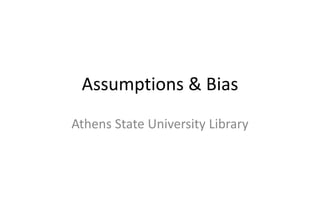
Assumptions & Bias in Argumentation
- 1. Assumptions & Bias Athens State University Library
- 3. Assumptions • Points in an argument that a writer takes for granted and doesn't prove with evidence. • We all make assumptions everyday based on our experience, culture, education and beliefs, and assumptions are present in every piece of writing.
- 4. Sources of assumptions • Senses – The impact of the senses is so elemental that we sometimes react to it without realizing we're doing so. • Experience – Each of us has a unique set of experiences, and they influence our responses to what we encounter. • Values – Values are deeply held beliefs -- often learned from families, schools, and peers -- about how the world should be.
- 5. Sources of assumptions • Emotion – Recognizing our emotional reactions is vital to keeping them from influencing our conclusions. • Self interest – Whether we like it or not, each of us sometimes injects what is best for ourselves into our decisions. • Culture – The culture we grew up in, the culture we've adopted, the predominant culture in the society -- all have their effects on us, and push us into thinking in particular ways.
- 6. Sources of assumptions • History – Community history, the history of our organization or initiative, and our own history in dealing with particular problems and issues will all have an impact on the way we think about the current situation. • Religion – Our own religious backgrounds -- whether we still practice religion or not -- may be more powerful than we realize in influencing our thinking. • Biases – Very few of us, regardless of what we'd like to believe, are free of racial or ethnic prejudices of some sort, or of political, moral, and other biases that can come into play here.
- 7. Sources of assumptions • Prior knowledge – What we know about a problem or issue, from personal experience, from secondhand accounts, or from theory, shapes our responses to it. • Conventional wisdom – All of us have a large store of information "everybody knows" that we apply to new situations and problems: it usually reflects the simplest way of looking at things.
- 8. Recognizing Assumptions • Identify the writer's claim. – What is the writer trying to prove? – What does he or she want readers to accept? • Look at reasons and evidence to support the claim • Reflect on what the writer has left unsaid or taken for granted about his or her argument, Assumptions are those ideas that hover in the background and must be accepted if the argument is to work.
- 9. Bias • Occurs when a writer displays a partiality for or prejudice against someone, something, or some idea. – Sometimes readily identifiable in direct statements. – Other times a writer's choice of words, selection of facts or examples, or tone of voice • We all have biases that reflect our opinions and our particular outlooks about life : perfectly normal and simply part of being human.
- 10. Recognizing Bias • Does the writer use overly positive or overly negative language about the subject? • Does the writer use emotionally charged language about the subject? • Does the writer use vague or generalized language about the subject? • Does the writer omit any important facts? • Does the writer add information and evidence that seems unnecessary just to bolster his or her point? • Does the writer fail to properly cite his or her sources?
- 11. Avoiding Bias • Create a scholarly voice – Generalization – Objectivity – Evidence – Self-Awareness – Sensitivity [Taken from Walden University's Scholarly Voice: Avoiding Bias ]
- 12. Avoiding Bias Generalization • Avoid stated or implied "all" or "never" assertions Objectivity • Too sympathetic; overly favorable opinion – provide a more balanced view Evidence • Support statements with research or answer the question "Says who?” – Use specific statistical data to support the idea
- 13. Self-Awareness • Be aware of your own biases and how these may be expressed in writing. • This includes: – Assumptions about professions • use gender-specific pronouns – Beliefs about specific populations • use specific statistical data to support the idea – Statements based solely on personal experience • use specific statistical data to support the idea
- 14. Sensitivity Sensitive language helps you avoid bias • Be specific rather than descriptive. • Keep wording parallel (male and female) • Be aware of sexual identity terms • Use parallel racial and ethnic identity terms. • Use "people-first" language when discussing labels (population with label)